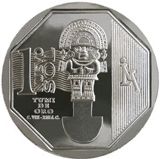As established by Law 25295, the currency unit of Peru since January 1991 is the Nuevo Sol. The Inti and Sol de Oro, our previous monetary units, have been withdrawn from circulation and are no longer legal tenders in the country.
With the aim of promoting our countrys important cultural heritage and fostering a numismatic culture, in 2010 the Central Bank started issuing the Numismatic Series called Wealth and Pride of Peru.
Arco Parabólico de Tacna Tacna
The National Coat of Arms, the inscription Banco Central de Reserva del Perú, and the year of minting are displayed in the obverse of all the Peruvian coins.
A composition that shows the Tacna Parabolic Arch (1959) and the Cathedral of Tacna is featured in the reverse side of the coin.
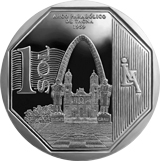
Shipibo-Konibo Pottery - Ucayali
The National Coat of Arms, the inscription Banco Central de Reserva del Perú, and the year of minting are displayed in the obverse of all the Peruvian coins.
The reverse of this coin features a Shipibo-Konibo pottery piece, two pottery pitchers with anthropomorphic designs, and some native houses behind.
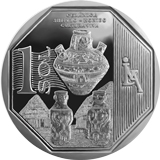
Archaeological Site Cabeza de Vaca - Tumbes
The National Coat of Arms, the inscription Banco Central de Reserva del Perú, and the year of minting are displayed in the obverse of all the Peruvian coins.
The reverse side of the coin reproduces in the center a composition of the Archaeological Site Cow Head (Cabeza de Vaca) made from adobe and stone.
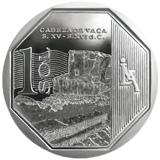
Vicus Pottery - Piura
The National Coat of Arms, the inscription Banco Central de Reserva del Perú, and the year of minting are displayed in the obverse of all the Peruvian coins.
A composition of two Vicus pottery pieces representing a duck and a deer is featured in the center of the reverse side of the coin.
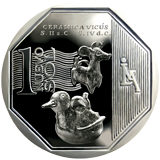
Huarautambo Pasco
The National Coat of Arms, the inscription Banco Central de Reserva del Perú, and the year of minting are displayed in the obverse of all the Peruvian coins.
The reverse shows a composition of a water fountain and an Inca bridge located at the Archaeological Site of Huarautambo in Pasco.
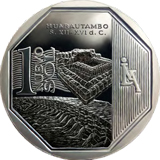
Moquegua Architecture - Moquegua
The National Coat of Arms, the inscription Banco Central de Reserva del Perú, and the year of minting are displayed in the obverse of all the Peruvian coins.
The reverse of this coin features an intersection of cobblestone streets lined by houses with the triangular or trapezoidal gable roofs distinctive of Moquegua architecture.
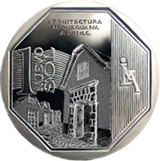
The Pusharo Petroglyphs Madre de Dios
The National Coat of Arms, the inscription Banco Central de Reserva del Perú, and the year of minting are displayed in the obverse of all the Peruvian coins.
The reverse side of the coin reproduces some of the most representative petroglyphs or rock engravings discovered in Pusharo in the region of Alto Madre de Dios. Experts claim the engravings could be as old as 2,000 years old.
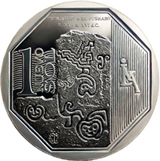
The Cathedral of Lima - Lima
The National Coat of Arms, the inscription Banco Central de Reserva del Perú, and the year of minting are displayed in the obverse of all the Peruvian coins.
The Central Reserve Bank of Peru (BCRP) put into circulation a new 1 NUEVO SOL coin featuring an image of the frontispiece of the Cathedral of Lima on the reverse side of the coin.
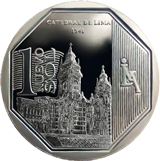
Antiguo Hotel Palace - Loreto
The National Coat of Arms, the inscription Banco Central de Reserva del Perú, and the year of minting are displayed in the obverse of all the Peruvian coins.
The façade of the Antiguo Hotel Palace, architecture masterpiece considered to be a part of Perus Cultural Heritage, is featured in the center of the reverse of this coin. The inscription ANTIGUO HOTEL PALACE 1912 appears on the upper side of the reverse.
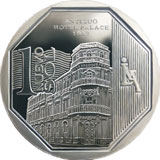
Huaca de la Luna - La Libertad
The National Coat of Arms, the inscription Banco Central de Reserva del Perú, and the year of minting are displayed in the obverse of all the Peruvian coins.
The reverse of this coin features the God of the Mountains, one of the major Mochica divinities depicted in the walls of the temples of this ancient ceremonial site, which are ornamented with colorful geometrical designs.
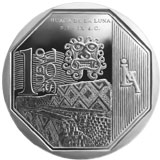
Sacred City of Caral - Lima
The National Coat of Arms, the inscription Banco Central de Reserva del Perú, and the year of minting are displayed in the obverse of all the Peruvian coins.
The reverse of this coin reproduces an aerial view of the Sacred City of Caral with its circular plaza. Caral is considered to be the most ancient city of the Americas.
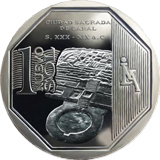
Archaeological Site of Tunanmarca - Junín
The National Coat of Arms, the inscription Banco Central de Reserva del Perú, and the year of minting are displayed in the obverse of all the Peruvian coins.
A gateway to one of the circular dwellings (chullpas) of the Citadel as well as part of this archaeological site is reproduced on the reverse side of this coin.
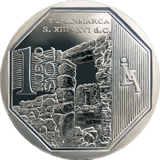
Paracas textiles - Ica
The National Coat of Arms, the inscription Banco Central de Reserva del Perú, and the year of minting are displayed in the obverse of all the Peruvian coins.
Two anthropomorphous figures used frequently in Paracas textiles are reproduced in the center of the reverse side of the coin.
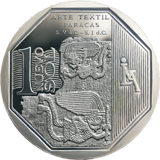
Temple of the Crossed Hands of Kotosh - Huánuco
The National Coat of Arms, the inscription Banco Central de Reserva del Perú, and the year of minting are displayed in the obverse of all the Peruvian coins.
The reverse shows a section of the Temple of the Crossed Hands of Kotosh in the background, with an expanded detail of one of the crossed hands clay sculptures found in this temple.
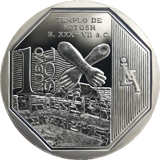
Inca Temple of Huaytará - Huancavelica
The National Coat of Arms, the inscription Banco Central de Reserva del Perú, and the year of minting are displayed in the obverse of all the Peruvian coins.
The reverse of the coin features the Inca Temple of Huaytará, built by Inca Yupanqui (Pachacutec) in the early 15th century. During colonial times, the temple was converted into a Catholic church, the San Juan Bautista Church, where mass is celebrated to this date using the original niches of the Inca Temple.
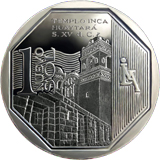
Kuntur Wasi (House of the Condor) - Cajamarca
The National Coat of Arms, the inscription Banco Central de Reserva del Perú, and the year of minting are displayed in the obverse of all the Peruvian coins.
A monolith representing a deity with feline features appears in the center of the reverse of the coin with the Kuntur Wasi ceremonial complex in the background.
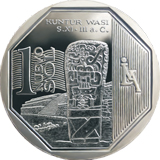
Archaeological Complex of Vilcashuamán - Ayacucho
The National Coat of Arms, the inscription Banco Central de Reserva del Perú, and the year of minting are displayed in the obverse of all the Peruvian coins.
The reverse shows the archaeological complex of Vilcashuamán, with the Templo del Sol and above it, the San Juan Bautista Church.
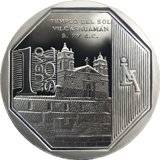
Real Felipe Fortress - Callao
The National Coat of Arms, the inscription Banco Central de Reserva del Perú, and the year of minting are displayed in the obverse of all the Peruvian coins.
The King's Tower of the Real Felipe Fortress and a pair of cannons that are exhibited in the Peruvian Army Museum are shown in the central part of the reverse.
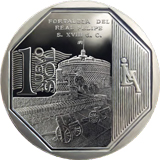
The Saywite Stone - Apurímac
The National Coat of Arms, the inscription Banco Central de Reserva del Perú, and the year of minting are displayed in the obverse of all the Peruvian coins.
The Saywite Stone, a 2.5 meters high monolith with over 200 zoomorphic and phytomorphic motifs as well as landform and human construction figures carved in the stone, stands in the lower part of the reverse, with details of the motifs displayed above it.
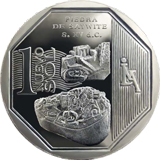
Citadel of Gran Pajatén San Martín
The National Coat of Arms, the inscription Banco Central de Reserva del Perú, and the year of minting are displayed in the obverse of all the Peruvian coins.
One of the walls of the Citadel of Gran Pajatén, decorated with human, geometric, and bird figures, is reproduced in the reverse side of the coin.
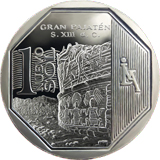
Machu Picchu - Cusco
The National Coat of Arms, the inscription Banco Central de Reserva del Perú, and the year of minting are displayed in the obverse of all the Peruvian coins.
The reverse side of the coin features the archaeological complex of Machu Picchu, declared a UNESCO World Heritage Site in 1983.
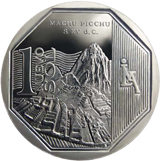
Monasterio de Santa Catalina - Arequipa
The National Coat of Arms, the inscription Banco Central de Reserva del Perú, and the year of minting are displayed in the obverse of all the Peruvian coins.
The reverse shows the architectural ensemble of Monasterio de Santa Catalina with the stone well of its Plaza Socodober in the foreground, the front of one of the nuns cells, and a view of the monastery church on the background.
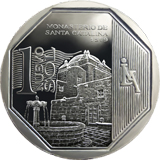
Chullpas de Sillustani - Puno
The National Coat of Arms, the inscription Banco Central de Reserva del Perú, and the year of minting are displayed in the obverse of all the Peruvian coins.
The reverse side of the coin shows the tower-like structures of Sillustani built by the Collas, an Aymara speaking tribe that dominated the Titicaca region before the Incas. The Collas buried their dead inside the up to 12m high "chullpas".
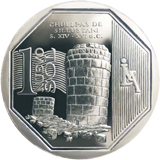
Estela de Raimondi - Áncash
The National Coat of Arms, the inscription Banco Central de Reserva del Perú, and the year of minting are displayed in the obverse of all the Peruvian coins.
The reverse of the coin shows the "Estela de Raimondi", a reflection without parallel of the artistic style of the Chavin Culture. The stela, a sacred carved monolith which was once worshiped at the ceremonial center of Chavin de Huantar, is made of granite and is 1.98m high and 74cm wide.
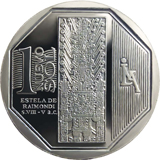
Karajía Sarcophagi - Amazonas
The National Coat of Arms, the inscription Banco Central de Reserva del Perú, and the year of minting are displayed in the obverse of all the Peruvian coins.
The reverse features one of the "Karajía Sarcophagi" found in the Amazon Andes on the edge of a cliff (Archaeological Complex of Chípuric). About 2.50 meters high, the real sarcophagi are shaped into big anthropomorphous capsules made of clay.
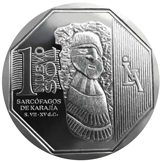
Tumi de Oro - Lambayeque
The National Coat of Arms, the inscription Banco Central de Reserva del Perú, and the year of minting are displayed in the obverse of all the Peruvian coins.
The reverse side of the coin shows the "Tumi de Oro", a typical Peruvian short bladed (semi-circular) knife with the mythological figure of "Ñaylamp" (Lambayeque Culture) as the handle.
